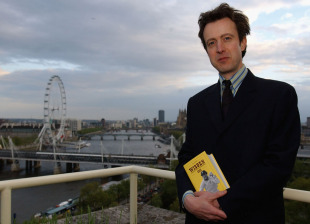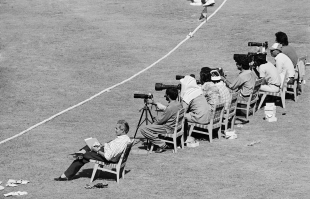What editing Wisden meant to me

|
|||
John Woodcock (1981-86)
Almost from the first moment I could read, I seem to have had a copy of Wisden at my bedside, and could never be separated from it as a cricket writer. But the thought of editing it had never occurred to me - until the seed was planted in the Long Room at Lord's at the wedding reception of Brian Johnston's daughter, nine days after Norman Preston, the Almanack's tenth editor, had died. Also at the reception was the managing editor of the then publishers, Queen Anne Press; the idea was floated, and things moved on from there.
That I managed to do the job at the same time as being the cricket correspondent of The Times was due to two people - Graeme Wright, who was to become my successor, and Christine Forrest, a neighbour of his and as dependable as she was receptive. Technically and administratively they were indispensable. For the first time in its history, Wisden was a cottage industry, operating from under my thatched roof in the Hampshire village of Longparish.
As the voice of cricket, it imposes on the editor a singular responsibility. If that sounds self-important, nothing that Sir Donald Bradman said in his letter to me on my appointment made me think otherwise: there was no doubting his affection and respect for the great work, nor the delight he took from his own collection.
It must still be fun choosing the Five Cricketers of the Year and keeping the cognoscenti guessing while about it, and the annual encyclical (dubbed Notes by the Editor) remains the one universally quoted cricket article of the year. But if offered the job again today, I'd know I would not be up to it. For one thing, like old John Wisden, I don't have an email; for another, I might submit to the need to put Twenty20 cricket in its place, and that would never do.
Graeme Wright (1987-92, 2001-02)
Being editor of Wisden was never my ambition, however much I was enjoying my involvement in the Almanack as assistant editor, first to Norman Preston, then to John Woodcock, and as the director of John Wisden & Co responsible for publishing it. However, the editorship, coming on John Woodcock's recommendation in 1986, was an honour not easily declined.
From a practical viewpoint, it enabled me to continue streamlining the day- to-day systems of the Almanack and, while meeting demands to build the value of the business, maintain a sensible cover price. What I might have wanted to do personally was very much secondary to what was best for the book. It was not what being editor meant to me, therefore, but what Wisden meant to others - not only current readers but readers in the future.
It seemed to me that the Almanack served manifold purposes. It was a book of record as well as records, it was literary and, most importantly, it had become an institution. Within the game, and indeed beyond the world of cricket, Wisden was trusted. Its continuity, its independence and the balance of its writing had won it the rare cachet of integrity. Posited between cricket's political and economic byplay and its passionate grassroots support, Wisden Cricketers' Almanack had established itself in the public consciousness as a voice of reason and the champion of everything, real and mythical, that cricket is meant to represent.
Maintaining this integrity and promoting the Almanack were what being editor of Wisden meant to me. There was nothing egotistical about it, that's for sure. But it was an immensely enjoyable time, thanks to the support, company and friendship of everyone involved in cricket, particularly the writers worldwide, but no less the administrators who, I see looking back, all too often bore the brunt of my Notes.
Matthew Engel (1993-2000, 2004-07)
Fallible memory suggests I took the call on the Bakelite phone we had received as a retro wedding present. It always crackled. But I was convinced I heard Graeme Wright ask if I wanted to be editor of Wisden, an idea that had never previously crossed my mind. I said yes instantly. Well, you would, wouldn't you? I never regretted it, even when wrestling with the Minor Counties before an icy December dawn, or enduring a particularly ghastly board meeting.
The book was on the up: John Woodcock had beefed up its cricketing and literary heft; Graeme had transformed its internal systems. But I sensed there was a fascinating challenge: making sure the book kept pace with the changing game, while remaining true to itself.
That much I hope we achieved in my first term. I made a comeback because I perceived a second challenge: adjusting to the fact that, in my three-year absence, the internet had gone from novelty to necessity. This task was thwarted by decisions taken well over my head, and remains ongoing.
The title "editor of Wisden" opened doors far beyond cricket. Within the game, the job ensured my opinions were always heard and sometimes listened to; now and again they even made a difference. It gave me a seat in the Test match press box, but the freedom to slope off. More than anything, I loved wandering round the county grounds, watching, enjoying the crack, and scrawling the odd note, that just might - the next April - blossom into a Note.
Mostly, the task was internal, but I loved that too: good writers wanted to be in Wisden, and it was a joy reeling them in. There was pleasure to be had even on a micro-level. I have spent years being absurdly proud that I changed Wisden house style for numbers so that, more elegantly, we used "ten" in text instead of "10". I have just been told by Wisden's deputy editor, Harriet Monkhouse, that I didn't actually do that. Having Harriet to correct my false memories was a special delight. I had a terrific team, and we laughed a lot.
Tim de Lisle (2003)
Editing Wisden meant a lot, despite, or because of, doing it only once. It meant driving a classic car, and feeling even greater respect for the engineers. (To the long-suffering permanent staff, it was probably more like an episode of Yes, Minister.) It meant receiving an email from a contributor saying, "Hope you've enjoyed your year of being George Lazenby." It meant being infamous for 15 minutes, when we announced that Wisden would have its first cover photograph. To Ian Wooldridge of the Daily Mail, this was "scarcely less heretical than slapping a picture of Judas Iscariot on future editions of the Holy Bible".
It meant standing on the shoulders of giants. John Woodcock had brought wisdom to the Almanack, Graeme Wright had widened its horizons, and Matthew Engel had added wit and waspishness. But there was still something missing. Ever since the social revolution of the 1960s, Wisden had been out of tune with the times, a curious fate for a yearbook.
We tried to make it brighter, livelier and more penetrable. We took the best section of the book, the front, and doubled it. We encouraged subscribers to order another copy for a tenner, for their son or nephew - or daughter or niece. And we made sure the cover reflected the previous year in cricket rather than just the ways of previous Wisdens.

|
|||
The designer was Nigel Davies, who has done more than anyone to make cricket publishing visually literate. He left most of the furniture in place, from the stumpy stature to the funny old font. The cover star was Michael Vaughan, in a shot chosen for its joy. It was black and white, to avoid clashing with the perennial primrose. Giles Smith in the Daily Telegraph said I had tried "to bring the Almanack kicking and screaming into the 1920s".
Scyld Berry (2008-2011)
In my four years, I tried to give cricketers more of a voice. I brought in the records of every Test player, so those of the past could be heard; and asked former players to write, when it was not the time for reporters to report; and had county players interviewed to follow them through their season. Wisden had always been strong on the what, where and when; less so on the how and why, perhaps because most editors had not played the game themselves. And I tried to do what it said on the tin, to make it a cricketers' almanack, as well as a cricket followers'. That is how it started when John Wisden, the former Sussex professional bowler, provided a player's view.
I also tried to make it the home of creative cricket writing by introducing longer feature articles than had been known before, insofar as the budget allowed. The revisionist assessment of Sir Donald Bradman on the centenary of his birth was the first; another the article on the 1911 All-India tour of England, the most extraordinary of all cricket tours, which took three years to come to print. And I tried to give Test cricket the primacy it deserves by commissioning eminent former players from various countries to act as selectors and pick their World XI for each year.
Many of the most interesting aspects of cricket have yet to be scientifically explained. As the batsman hits a cover-drive off a fast bowler, what goes on in his brain, because it is a physical impossibility for the untrained brain to react in time? Why do bowlers, often left-arm spinners, get the yips? So much remains to be unearthed. The Test-match game is the thing, and what the ball does is its essence.
Lawrence Booth (2012-)
I picked up my first Wisden in 1990, having just turned 15, from Blackwell's, Broad Street, Oxford. It cost £15.50 (you've got to love the 50p), which probably made it the most expensive book I had ever bought. But until I'd stumbled across old copies of the Almanack in my school library a couple of years earlier - Mr Noll, the head of history who doubled up as librarian, was a cricket nut - I hadn't even known it existed. Now I was hooked. And if anyone had told me I'd be editing the thing a couple of decades later, I'd have questioned their sanity.
The job was just too implausible to have counted as an adolescent dream and, when the possibility cropped up out of the blue, I may have kept my composure. Matthew Engel, whose editorship I had been lucky enough to work under, once compared editing Wisden to a tropical garden - so much pruning and chopping. Wonder of wonders, I'd been allowed in to smell the orchids. Thanks to Scyld Berry, the place was pristine.
What have I had to do in the first two years? Maintain the book's exacting standards, of course, which - it turns out - does not happen overnight. But also extend its relevance beyond its pages. Our website now bears some of the strain. Facebook and Twitter play their part too; Sydney Pardon would have been a formidable tweeter.
Above all, the internet means we have to fine-tune the relationship in Wisden between words and numbers. It's always struck me how many people think of it as a book of stats, when it contains so many interesting stories too. Changing perceptions is one task. Another is to remind myself that the age of instant comment still has room for the more considered perspective - perhaps more than ever before.

